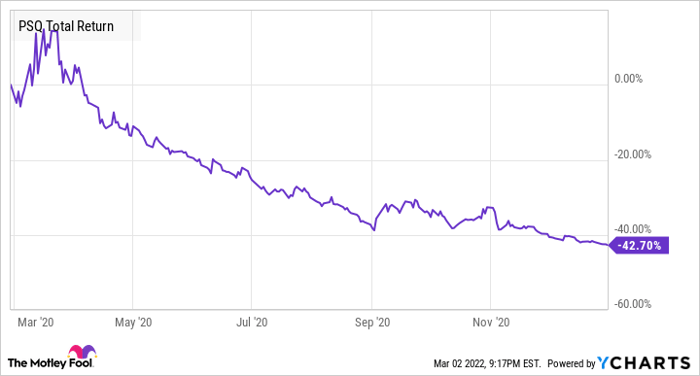As the stock market tumbles, many individual stocks are falling with it. That makes short and inverse exchange-traded funds (ETFs) more tempting, as they seem to promise one simple trade to profit while stocks are falling across the board. Unfortunately, it's not that simple. Inverse ETFs can be helpful tools, but you have to use them correctly.
How inverse ETFs work
Inverse ETFs are designed to rise when their target benchmarks fall. The fund managers typically use short positions and options to achieve this. For example, the ProShares Short S&P 500 ETF (NYSEMKT: SH) is designed to produce opposite returns to the S&P 500 index each day.
That's all pretty straightforward at face value, but there are some important details to consider. These funds are designed to invert an index or benchmark's single-day performance, not the long-term returns. Short ETFs are typically rebalanced each day. As a result, an inverse ETF's performance can diverge from its benchmark over weeks and months.

Image source: Getty Images.
Leveraged ETFs are also popular for short exposure. The ProShares UltraPro Short QQQ (NASDAQ: SQQQ) is an incredibly popular fund designed to triple the inverse performance of the NASDAQ 100. The management team uses derivatives called swaps to achieve that performance.
Risks of inverse ETFs
That divergence is one of the most prominent risks or downsides of short ETFs. They might not live up to your expectations in a bear market.
Another serious downside is unavoidable fees that reduce gains and magnify losses. Inverse ETFs utilize relatively active strategies with high trading volumes. It costs money to make trades, there are fees associated with shorting, and the fund has to pay employees to carry out all that methodology. That all results in high fees for shareholders. The ProShares Short S&P 500 carries a 0.9% expense ratio, while the ProShares Short QQQ (NYSEMKT: PSQ) charges 0.95%.
Those are important risks to consider, assuming you can time the market and buy an inverse fund when stocks are falling. Things can get ugly pretty quickly if the market is moving against you. The ProShares Short QQQ lost nearly half its value from March 1, 2020, to the end of that year.
PSQ Total Return Level data by YCharts.
Compounding can unlock an almost magical effect for long-term returns. The exact opposite can happen for inverse ETFs if held for extended periods. This issue is even more pronounced with leveraged products.
How to use short ETFs
Unless you're a trader, inverse ETFs are sort of preemptive bandages. They're a useful tool for short-term hedging. If your portfolio is overexposed to volatility, short funds allow you to dampen the impact of short-term market shocks. They're not really designed for long-term holdings.
Most investors shouldn't attempt to time markets anyway. History shows us that it's nearly impossible to pick out the tops and bottoms of stock market cycles with any sort of consistency. You can sabotage long-term performance by selling your stocks out of panic and fear -- going heavily into inverse ETFs would only exacerbate those problems.
Great investors accept volatility as a natural part of the stock market. They prepare ahead of time to balance volatility and growth based on their investment goals and cash needs. If you are thinking about inverse ETFs, make sure they aren't a central part of your strategy. Think of them more as a safety valve to hold for a few days or weeks at most.
10 stocks we like better than Short S&P 500 ProShares
When our award-winning analyst team has a stock tip, it can pay to listen. After all, the newsletter they have run for over a decade, Motley Fool Stock Advisor, has tripled the market.*
They just revealed what they believe are the ten best stocks for investors to buy right now... and Short S&P 500 ProShares wasn't one of them! That's right -- they think these 10 stocks are even better buys.
*Stock Advisor returns as of January 20, 2022
Ryan Downie has no position in any of the stocks mentioned. The Motley Fool has no position in any of the stocks mentioned. The Motley Fool has a disclosure policy.
The views and opinions expressed herein are the views and opinions of the author and do not necessarily reflect those of Nasdaq, Inc.



